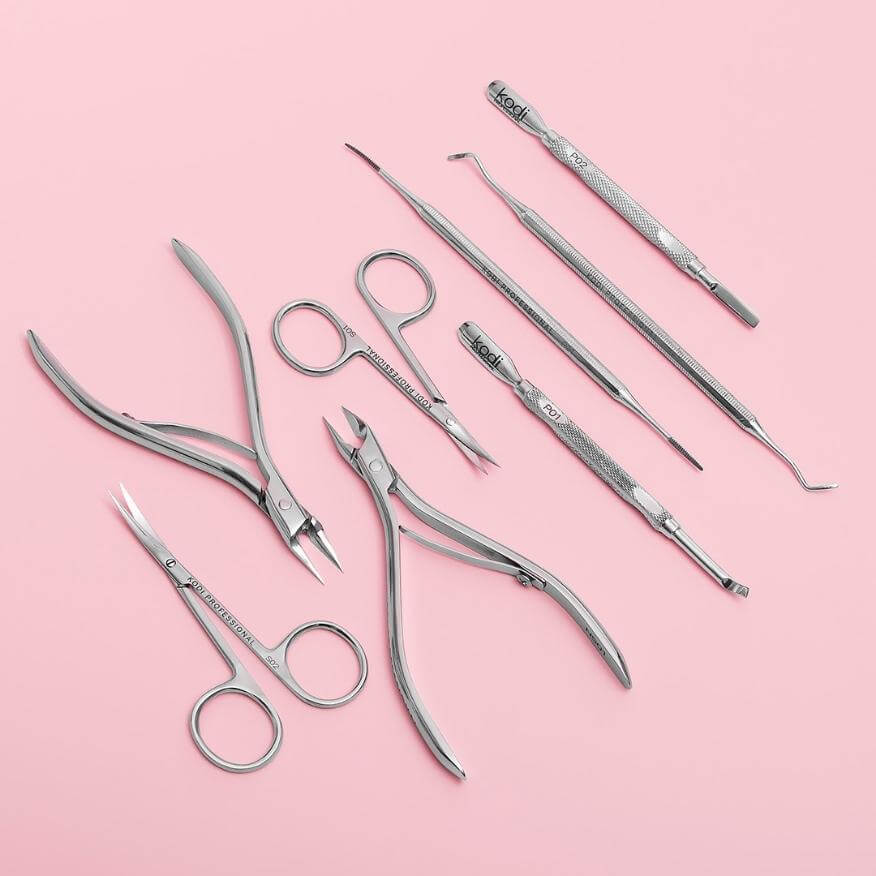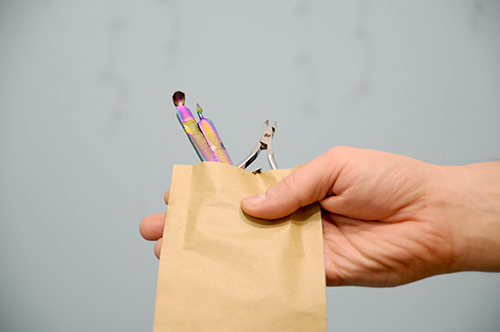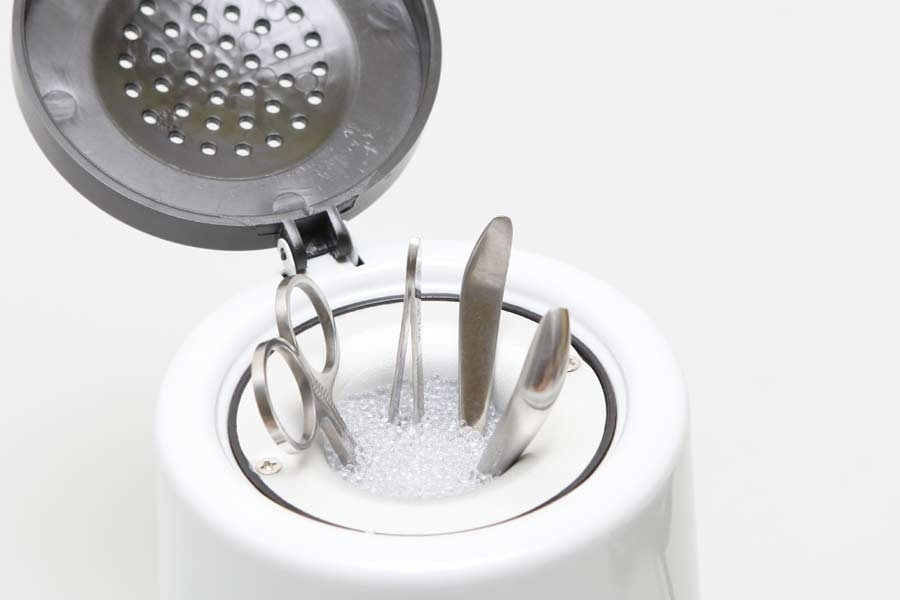
Sterilization of manicure instruments

Galina Tischenko
KODI PROFESSIONAL International Instructor Trainer
Disinfection and sterilization of manicure tools is a guarantee of safety and quality of nail care. The health of the beauty salon client depends on it. Sterilization is necessary, even if you treat your nails yourself and no one uses the tool except you. How to properly treat the tool? What disinfectants are used? How to care for files, buffs, cutters?
Treatment of manicure tools
The need to disinfect tools is dictated by the very process of nail care. On files, nail clippers, cutters there are particles of biomaterial, which may contain bacteria and viruses that can penetrate into the body and develop, causing hepatitis, nail fungus, human immunodeficiency virus, various diseases of the nail plate.
From untreated tools risk infected not only the client, but also the master himself, so their treatment is extremely important and is part of the job duties of the master.
The correct treatment of instruments involves several steps:
- Direct treatment with disinfectants.
- Cleaning of the instruments.
- Sterilization.
- Proper organization of storage of treated materials.
How to sterilize manicure tools?
The simplest and most affordable way of disinfection is to treat the tools with a disinfectant solution. This method is suitable for those who do their own manicure, using tools only for themselves.
- Take a container resistant to chemical reagents.
- Pour into it half a liter of clean boiled water.
- Add a disinfectant solution, which can be purchased in any medical equipment store. The required volume is 5 ml.
- Lower the tools, cleaned from filings, skin residues in water for 5 minutes.
- Clean the instruments again with a brush and rinse under running water.
This method does not guarantee full sterilization, but is suitable for individual use at home.
For treatment in a salon environment, special sterilization devices are used. These include:
- A desiccator. This device kills bacteria and viruses by exposure to high temperatures. Dry-erase sterilization is suitable for
- steel instruments that can withstand the treatment. Tweezers, scissors, clippers, metal saws, cutters, milling cutters are placed in it for 20 seconds and removed immediately after treatment.
- Steam sterilizer (autoclave). In it, processing is carried out with hot steam. For high-quality disinfection, the devices are laid out in one row. The duration of the process is 20 minutes.
- Ball sterilizer (glasperlene). This means for sterilization is used only for metal instruments. The essence of the work of the device is in the rapid heating of quartz balls (up to 240 degrees) and their treatment of tools. After this device, you can wash the tool with a disinfectant solution and use it.
- Ultrasonic container. In this device, processing is carried out by ultrasound, where with the help of vibration contaminants, traces of corrosion are removed.
- Ultraviolet irradiator. Such a sterilizer treats instruments with UV rays.
- Chemical disinfection. Chemical sterilization of manicure tools requires reagents, room, overalls and compliance with safety rules.

- Treated tools must be stored correctly. For this purpose are used:
- Kraft bags. These are paper bags that close with paper clips and allow the instruments to remain sterile for three days.
- Heat-welded bags. They hold treated instruments for up to a month while remaining sterile.
- Bags with a closing valve. They keep sterility for up to 20 days.
Since salons have a high client traffic and do not need to store tools for a long time, Kraft bags are popular.
How do I sterilize the cutters?
According to the requirements of sanitary norms, manicure cutters undergo several stages of processing to completely eliminate the possibility of transmission of harmful microorganisms, bacteria and viruses from person to person.
- Removal of biological dirt: sawdust residue, keratinized skin particles.
- Disinfection. It is carried out with special chemicals or physical methods (incandescence in a dry heat cabinet).
- Pre-sterilization cleaning or treatment under running water.
- Sterilization in a desiccator, autoclave, ultrasonic sterilizer.
How are ceramic and corundum cutters machined?
Ceramic cutters are disinfected in an ultrasonic bath with a special solution. To protect the cutter from the negative effects of the device, you can put a special protective cap on it. After ultrasound treatment, the cutter is washed under running water and then air-dried. The next stage is sterilization in a ball sterilizer or a dry heat cabinet.
The final stage of work with the tool - placing it in a kraft paper bag.
Corundum cutters do not require specific care and are sterilized together with other metal manicure tools. The first stage of processing - removal of biomaterial residues, the second stage - placement in a Glasperlene-type sterilizer, where under the influence of high temperature all dangerous microorganisms die.

How do I sterilize files and buffs?
Ceramic cutters are made of plastic materials that will not withstand chemical treatment or heating in a dry heat oven.
The exception is metal nail filing files, which can be treated in dry heat, but the metal may darken and the file may lose its attractive appearance. For inexpensive polishing saws, disinfection is not provided. They are discarded after use. More expensive tools are treated in an ultraviolet sterilizer.
The simplest way of treatment - washing under running water, the next stage - drying in the air and treatment with disinfectant liquid. Soaking in a solution is not a suitable method of treatment, as few files can withstand it.
Files and buffs treated with the solution are placed in kraft bags or wrapped in kraft paper.
How to sterilize manicure tools at home?
Care of the tool should be done in a specific sequence. You should do this every time you perform a nail care and cuticle removal procedure.
- Wash the tools under the tap using a soapy water solution.
- Place the forceps, scissors, metal file, and poucher in a tub of water and disinfectant.

- Carry out sterilization. A pot of boiling water or a kitchen oven can be used as a sterilizer at home. Boil the instruments in the pot for 20 minutes. If you are using an oven, heat it to 200 degrees, carefully arrange the instruments in a clean metal tray and place in the oven for 15 minutes. Take the tools out and allow them to cool. Wrap them in kraft paper. Another method of sterilization is to hold instruments over a fire, but it is not easy or safe.
In addition to heat sterilization, chemical treatment can be used. At home, instruments can be cleaned with vinegar, 70% alcohol solution. It is also allowed to use a solution of formalin and soda, 6% hydrogen peroxide. Also for home use, you can buy special disinfectants, for example: "Bacillol". In such a solution you need to dip the tool for 5-10 minutes, after which they can work.
If at hand there is no alcohol or "Bacillol", use "Miramistin" or "Chlorhexidine", which are available in almost every family medicine cabinet.
Rinse files and buffs with running water, dry and treat with a disinfectant solution. If you have soft polishers, with abrasive tape glued on the edge, change them more often. This is not only hygienic, but also useful, because in inexpensive file-buffs abrasives quickly wear off and do not process the surface of the nail as they should.
In addition to the treatment of tools, the treatment of hands is also important. Be sure to wash your hands with soap and water before starting a manicure. You can use a special gel-antiseptic. In the salon, the master is also obliged to offer the client sterilization of hands, as well as put on clean gloves or disinfect his hands.
Clean should also be the workplace. If you are doing manicures at home, make sure the table is clean. Only put your tools on a clean surface.
Sterilization of manicure instruments with alcohol
The use of alcohol and alcohol solutions for sterilization of manicure tools is acceptable only when they are in domestic use and the woman works with them alone. Even under this condition, the tool should be boiled once a month in distilled water. Then you will not be afraid of fungi and other diseases.
If the tool is used in a beauty salon, then sterilization with alcohol will be insufficient and the possibility of infection will be great. In this case, it is necessary to use additional devices and appliances: oven, ultrasonic sterilizer and so on.
Which manicure tools need to be sterilized?
All manicure accessories can be divided into two large groups: porous (files, buffs) and non-porous (metal tweezers, pushers). Porous items are mostly disposable, but there are also reusable, requiring special cleaning. Non-porous tools are reusable and easy to clean.
- Porous items are cloth, absorbent and wooden items such as nail files, cotton and orange swabs, sponges, paper towels and tissues, and polishing buffs. Most of these are single-use items and do not need to be sterilized. Exceptions are saws, but during disinfection, care must be taken to ensure that the surface does not break down after contact with liquid, if this begins to happen, the saw must be disposed of.
- Non-porous tools are made of metal, plastic, glass and fiberglass. This type includes cutters, scissors, tweezers and so on. All of these items require sterilization after each client.
Cleaning methods based on tool ownership are divided into:
Items that do not come into contact with the skin of the client (gels, acrylics, colored varnishes, gel varnishes) do not carry various microorganisms, so for them there is no need in the sterilization process.
Sterilization steps
The process of disinfecting and sterilizing the instruments requires strict adherence to the instructions, otherwise you will not be able to guarantee their safety. All treatments require a large amount of time, so the master needs to have several sets to work with. Cleaning consists of such stages:
- After the work with the client is completed, the tools used for the manicure procedure are thoroughly washed in running water with soapy water and cleaned from visible contaminants.
- Then the items are placed in a tray with disinfectant liquid and are there for the necessary time (recommended by the manufacturer).
- Instruments are sent to the sterilizer for final removal of all microorganisms from their surface.
- The clean items should then be packed in airtight bags to keep them clean until the next use.
Before starting work, open the tool bag in front of the customer and treat it again with disinfectant or alcohol.
Leave a review or ask
a question to the master
 Cabinet
Cabinet



 (0)
(0) 4406
4406














